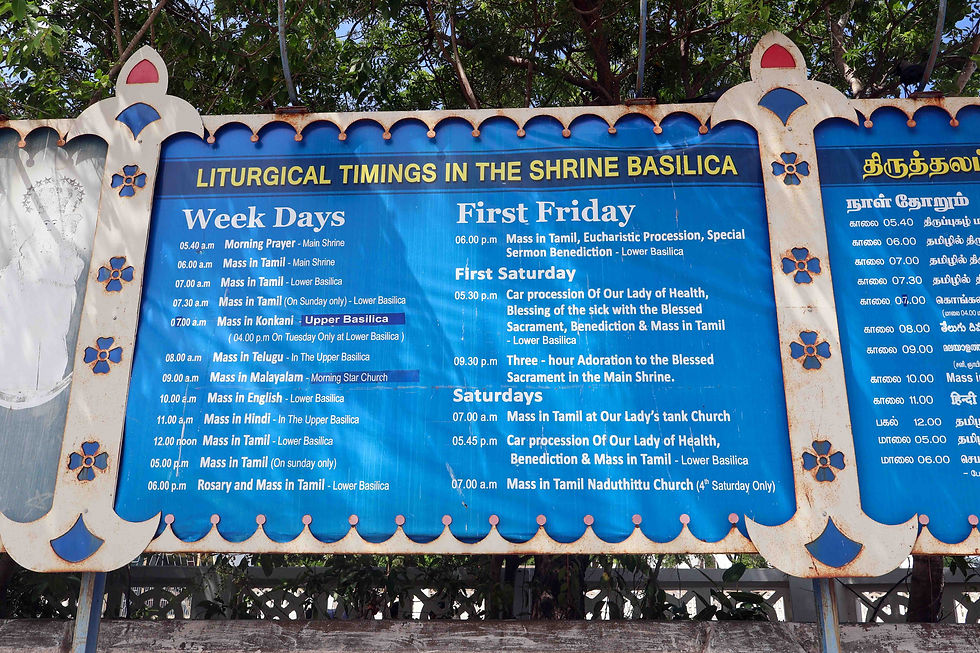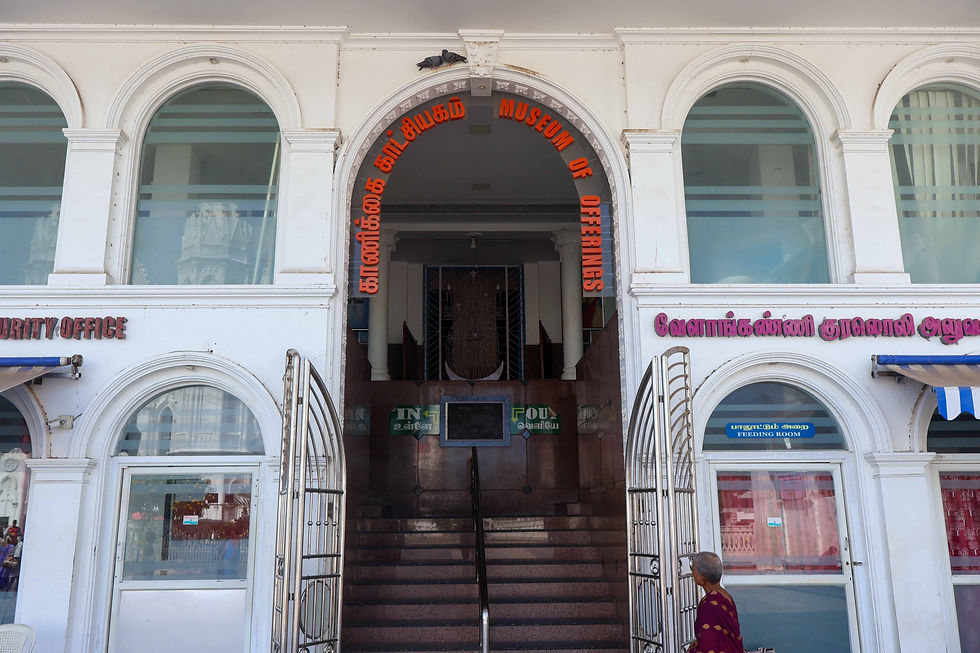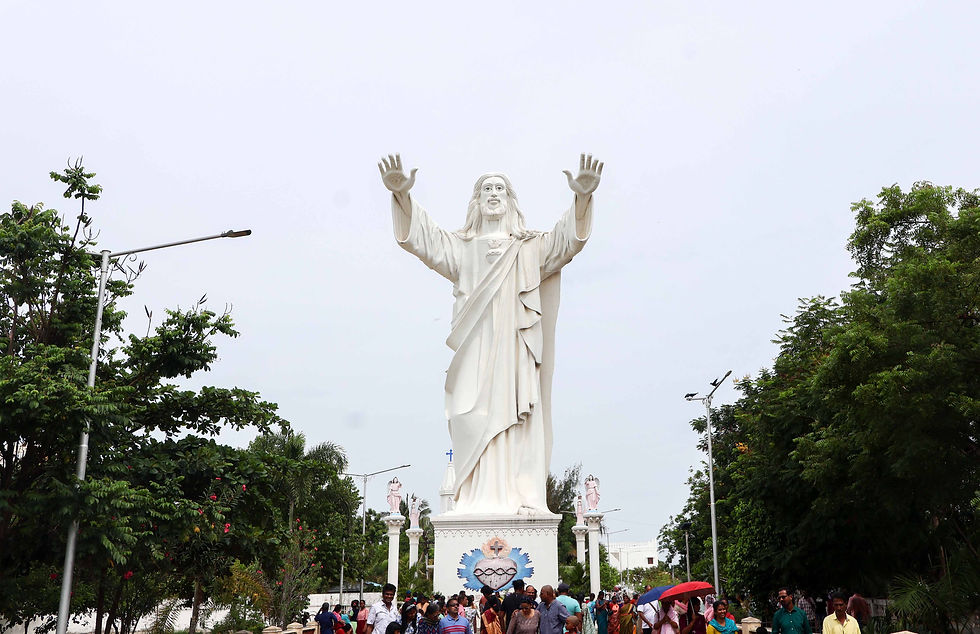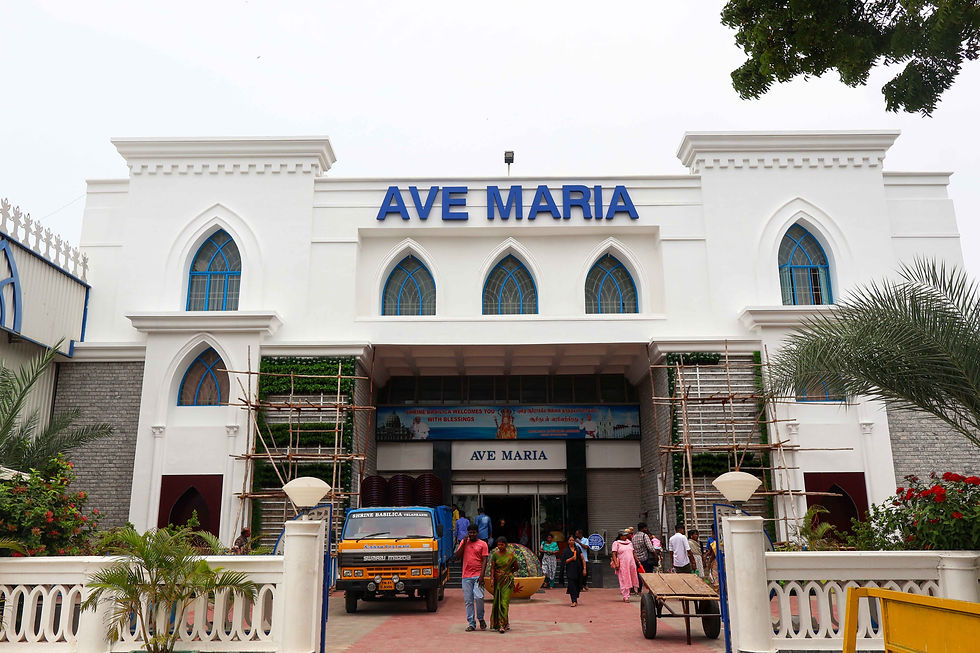Pilgrimage to Velankanni
- Adrian David

- Jul 5, 2024
- 6 min read
What springs to your mind on hearing the names Fatima, Lourdes, Međugorje, Guadalupe? The common thread connecting these sacred sites is the apparition of Mother Mary at different points in time.
Among these revered destinations is Velankanni, a pilgrim town in the southern coast of India. This is where the Holy Virgin appeared not once or twice, but thrice.

Velankanni welcomes millions of pilgrims every year from all around the world. Its reputation as a place of miracles and spiritual solace has spread far and wide, so much so that Pope John XXIII aptly called it as the ‘Lourdes of the East’ in 1962.

The name ‘Velankanni’ means the Virgin of Velan, where virgin refers to the Holy Mother and Velan refers to the former name of the town. Once upon a time, this pilgrim town used to be a bustling trading port that traded with Rome and Greece.

Having long wanted to visit this place, I finally embarked on a solo trip and spent three days here, surrounded by the divine presence and sacred shrines.

Three main shrines, each related to an apparition, form the heart of this pilgrim town.

Our Lady’s Tank (Matha Kulam)
During the 16th century, a young shepherd boy was on his way to deliver milk to a customer’s home, going about his daily routine. Tired of walking under the sun, he rested under a banyan tree near a pond.
He was woken up from his slumber when Mother Mary appeared to him, holding the infant Jesus in her arms. She gently requested milk for her son, and the boy gladly obliged and poured her some from his pot.
On reaching the customer’s home, the boy apologized for being late and narrated about what happened on the way. To both the surprise of the boy and his customer, the pot of milk was full to the brim. That man, also a Hindu, asked the boy to take him to the apparition site. When they reached the pond, the Holy Mother appeared once again.

News of the miracle spread, and the local community rejoiced. From then on, the place is known as Our Lady’s Tank (Matha Kulam).

A beautiful chapel was eventually built at the spot. This miracle was just the first to happen in Velankanni, marking the start of a series of Marian apparitions that would establish the town as a sacred pilgrimage site.


Nadu Thittu
Years after the first miracle, the second happened. A crippled boy was selling buttermilk near Nadu Thittu (central high place). Mother Mary appeared before him and kindly asked for buttermilk, which he humbly offered. She then entrusted the boy with conveying the news of her apparition to a Catholic merchant in the nearby town. The boy rose up and rushed to inform the man. Little did he realize that his crippled leg had been miraculously healed.

The merchant, who had a vision the previous night in which Mother Mary asked him to build a chapel, was overjoyed to receive the boy’s message. Together, they both returned to the site of the miracle and built a thatched chapel. Over the centuries, a church was eventually built.


This miracle earned Mother Mary the revered title of Our Lady of Good Health (Arogya Matha), a name that will echo through the ages to come.

Shrine Basilica of Our Lady of Good Health
The third miracle took place in the 17th century when a Portuguese merchant ship sailing from China to Sri Lanka was caught amid a raging storm. Fearing for their lives, the sailor and his crew invoked the divine intervention of Mother Mary to rescue them.

They vowed to build a church in her name wherever they landed. Miraculously, the turbulent sea turned calm, and the ship reached safely on the shores of Velankanni on September 8th, coinciding with the Feast of the Nativity of the Blessed Virgin Mary.

True to their promise, the sailors transformed the humble thatched chapel, built by the Catholic merchant, into a quaint shrine. Today, it stands as the Basilica of Our Lady of Good Health, a magnificent white church built in the Gothic architectural style.


During their subsequent visits, the Portuguese crew renovated and beautified the church, adorning the altar with exquisite porcelain plates. The original altar is preserved to this very day.

Although the three apparitions inspired the building of a shrine to Mother Mary, it was the promise made by the Portuguese sailors that eventually led to a permanent church in Velankanni.

As time passed, a grand white marble church was built as an extension to the original one.

With two ornate altars spanning two floors, the Basilica exudes reverence, evoking a sense of deep devotion in all who enter.


Only when I saw a panoramic photo of the church did it dawn on me just how massive it is.

I attended the English Mass in the lower Basilica during my stay, and the sermons were spiritually enriching.

In addition to English, the shrine offers worship services in five other languages to cater to devotees from far and wide.

Like many churches, Velankanni has blended local customs and cultural traditions, which are reflected in its rituals. Chief among them is the custom where devotees drape the statue of Mother Mary in a silk sari, a traditional dress worn by Indian women.

Yet another significant ritual is the tonsuring of hair, where devotees shave their heads, offering their locks as thanksgiving. Near the church, a special tonsuring area is set aside for this purpose, run by barbers who shave the heads of willing pilgrims.

Inside the main shrine, I spotted rows of pilgrims with shaved heads, their scalps smeared with sandalwood paste.

Along the long, narrow stretch featuring the Stations of the Cross, pilgrims walk on their knees under the searing sun, sincerely praying to God to answer their specific intentions.

Witnessing this depth of devotion, especially among little children, was humbling.

Speaking of specific intentions, pilgrims tie small makeshift cradles made from handkerchiefs to a tree, hoping to be blessed with a child. Others tie a mangalsutra (a yellow yellow thread worn by Hindu women as a symbol of their marriage), praying for a suitable life partner.
It’s worth noting that pilgrims from diverse faith backgrounds visit Velankanni and some of these customs have their roots in Hindu culture.

Pilgrims whose prayers are answered often show their gratitude by presenting offerings to the church, accompanied by a note sharing their story. These offerings, including gold and silver icons and crosses, are displayed in the Museum of Offerings.

From healing and childbirth to countless other blessings, these testimonials serve as a poignant reminder of the miracles attributed to Velankanni.

Besides the three main churches, Velankanni is home to several other sacred spaces, including the Morning Star Church.

The name is inspired from Revelation 22:16 where Christ refers to himself as the Morning Star. “I, Jesus… am the Root and the Offspring of David, the Bright and Morning Star.”
Completed in 2013, this is both the newest and the largest church in town, with a seating capacity of 10,000 and accommodating 40,000 devotees standing.

The church’s altar was awe-inspiring, adorned with artistic paintings depicting the life of Christ and Mother Mary.


A towering 20-foot statue of the Sacred Heart of Jesus stands outside the church, a reassuring symbol of Christ watching over all of us.

The Church of Preparation for Reconciliation, a lovely adoration chapel situated near the main shrine, provides a peaceful sanctuary for contemplative prayer and self-reflection.



The shrine’s office features a prayer service where priests are always available to pray for the specific intentions of incoming pilgrims. Additionally, we could request mass offerings for specific intentions by ticking the checkboxes on the forms provided. I was grateful to have dedicated a few masses for the intentions of my relatives and friends.


The Retreat Centre is another valuable resource, organizing spiritual retreats for groups on a range of topics.

Throughout my stay in Velankanni, I was enveloped in lush greenery, whether I was gazing out my window in the morning or strolling to the church. A serene experience indeed.



The street outside the church complex was a bustling marketplace selling religious articles, souvenirs, snacks, and a host of local goods.

Situated at the street’s end, the Our Lady of Sorrows Chapel is an intimate sacred space where locals briefly stop to offer prayers as they go about their day.


Crossing through the vibrant street, I reached the beach, cast with the warm glow of the sunset. A perfect spot for pilgrims to unwind after a spiritual experience at the shrine.

The fresh catch of the day was marinated and deep-fried to golden crisp, served hot at the beach, making for a delicious evening snack.

Five centuries after the shepherd boy witnessed the first miracle at Velankanni, yet another boy, I, was blessed to have visited this town.

Velankanni is a land of miracles, where the divine touches humanity. Just like how God rescued the Portuguese sailors who were stranded at sea and guided them here, He continues to guide countless pilgrims to this sacred shore, transforming lives with His unconditional love.



